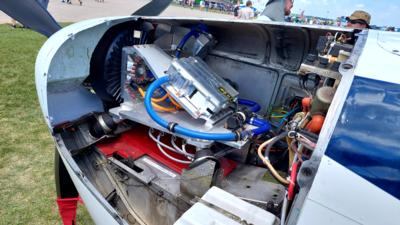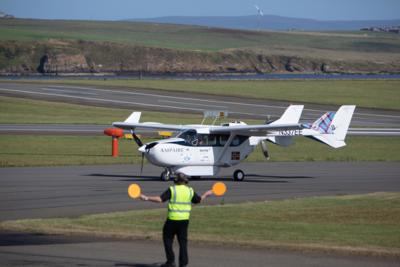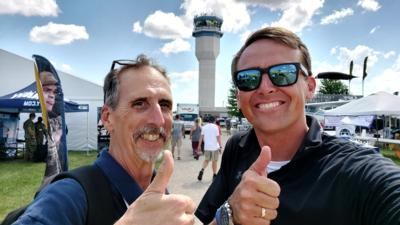Elliot Gives An Interesting, In-Depth, Perspective On The EEL, E-Flight As Only Few Can
By Anthony J. Liberatore
Q: So Elliot, tell me about your amazing journey here in the Ampaire EEL from California.

A: We call it the EEL, the electric EEL. So yes, the airplane was configured for a short duration, like airline hops, the islands, Scotland, Hawaii, where other airlines regularly running that only go maybe 20 minutes out and 20 minutes back. When you think about it, the goal has always been electric coast to coast, on electric, across the Pacific and while that's beautiful, we're not going to start there, and we sort of start at the other end. So, you're starting at the bottom, what's the shortest haul airline out there. Think of the electric motor as a climb assist, use the electric to get off the ground, get up to cruising altitude then you turn the electrical off, fly on the ReCip to your destination, arrive at the destination land, do another takeoff coming home, land, and have enough for a go around should it be required, and that's what sizes the system needs on that airplane. It becomes interesting when the company, this was maybe three years ago, we started this project.
They've now done three of these Skymasters with varying amounts of motor and battery. But now three years later, we've started taking it on the road. We took it to Hawaii and flew between the islands. We took it to Scotland and flew between the islands showing that the concept works. They came up with this idea of bringing it to Oshkosh. Well anyways, they reached out to say Elliot will you take the EEL to Oshkosh? I said sure, we'll look into it. We started researching and said, we’ll just put chargers all across the country, that's easy. So, you start reaching out, you call the FBO’s, you call the jet centers, you say I need some 220 volt 3 phase, on Tuesday, the 23rd. The person behind the desk answers the phone, and they don’t know what you're talking about. So, you take that, and you spread that out between the northern route that takes you up to Cheyenne, or the southern route that takes you through Phoenix. And you start to look at a lot of different airports, could end up at as
to understand which airports you could land at and have chargers pre-staged at these locations. So, I started asking myself, can we physically get there, without recharging, what that fundamentally means is you're using as little electric as possible to take off, with as much gas as you can carry aboard. Every takeoff gets you as far downrange as possible, and that's what we spent the last three months doing.

Q: So as a logistic issue, was there any possibility of you dovetailing off Tesla (or other brands of) supercharging stations that just might be co-located on airports or adjacent tan airport? Or was that thin soup?
A: That's a fantastic question. You know, I don't know if they got that far. I had a team of engineers I would ask the questions to, and then I would make my decisions based on their responses. So, I don't know if they went as far as that. Anyway, we get the airplane here at Oshkosh, I come into land, and I
had to two takeoffs worth of electric, that means if I could do an abort here, and then I could go to my abort airport and do another abort, which made me feel confident if a Pietenpol pulled out in front of me, I was assured of surviving. When we get to the hangar, instead of being able to find the same 220 volt 3
Phase that we've been looking for, they have a big diesel generator, that was the only way that they could charge the airplane. And then you get the look you just did right, you shake your head, and many people feel the same way about it. They're hiding the diesel generator, I said, hey, timeout, I said, this is the problem. We knew where we were going, and we couldn't get power. Imagine if you're trying to move an airplane like that across the country. So anyway, people get wound up about exactly how efficient hybrid is, and whether or not hybrid makes sense right now, and these are all very valid concerns. What I have gained most about that program is learning about scope of electric, I.E., what it is to regularly fly, charge an electric airplane, and to live with it in the cockpit. And then these infrastructure problems, the FAA problems, all the rest of the stuff that has to be solved just as fast as the hardware problems. The new airplanes, the new batteries, all the big stuff, right. All those
problems have to be solved if we're ever going to be serious about electrical aviation, whether or not that happens.
Q: Even with electrical automobiles, I've had some interesting discussions with those that are in it that area, and the reality it's quite different than what the proponents are proposing. The big thing is infrastructure and how you're going to power all off this. Case in point, Gen-Four Nuclear Power is still a dream on the drawing boards, which could give you small safe units that could in your municipality and charge all of the above, and the challenges go on from there.

A: So as we talk about this very quickly, it turns into a policy discussion when we're talking about whereas a country we want to invest. And I guess that's what I find most interesting about the EAA response and when I say EAA’s I don't mean the organization, I mean the people, the people of EAA's response to the EEL being here has been so positive people are so excited about that airplane. I find that very exciting in the fact that, you know, aviators tend to slant “Red” and very quickly any of these discussions about “E” stuff become political discussion. So, the fact that we can actually talk tech, is a great indicator of just how this group is exactly the group I want them to be, hardcore experimenters.
Q: Speaking of tech, for a while we had PHEV in our family that could go 20 miles on pure electric. It was addicting with its linear torque curve, and level of quiet and smooth to boot. What did you experience in that regard, with the EEL motor, and what brand of motor is it if you can disclose that?
A: So the company is not talking about what the motor is exactly, but it's one of several electric aircraft that I've flown, and I think you're hitting exactly the nail on the head.
Q: In regards quiet, smooth, and torque?
A: Well, and it's remarkably simple to get great power from an operator standpoint. I mean, I think aviators, you know, we like being able to have knobs to fiddle with. So, you find yourself in cross country being bummed, that you don't have a lever to play with, but is that's just the fact. I mean, electric is fundamentally just a lot simpler. You hear things like, oh well, with a battery, unless you have a draw on it, you're not going to know how much battery you have left, or if you run it really hard versus really light, your range varies dramatically. That's true about a regular airplane, too, and none of these are that interesting of problems to solve, it's mostly a cultural problem. It's mostly what is the experience of the average aviator problem, and that's, why an airplane like Ampaire is so important, because it's just raising the awareness.
Q: Are you using Re-Gen on descent?
A: Great question. I would say Re-Gen on descent is the same answer as Why don't you charge the battery using the rear motor. And fundamentally, it comes down to its way more efficient to save energy by gliding further down range then effectively breaking using Re-Gen to put it back in the battery. That's why Re-Gen in aviation will always be probably not worth the squeeze. The other side fundamentally is with that mission is the 20 minutes downrange like the Hawaiian island mission, you're just not airborne long enough to put any sizable number of calories back in the box.
Q: With energy density is increasing, but not at Moore's law, Is the team looking at the whole Solid State Battery arena and the players therein, and are you having discussions with them, or is that proprietary?

A: I mean, of course, it's proprietary, and of course, everybody's looking at the same tech that's coming in, everybody wants the same thing. I think, again, what excites me about the Ampaire is not the if you go to their website, you're going to see cartoony drawings of the magical airplanes, and everybody knows they want, and we all know we're a long ways off the horizon. That's not what's interesting about that company. What's interesting about that company is the practical airplane sitting in that ramp right now that flew, you know, 1000 /1500, miles out here that has 100 hours of me sitting in the seat flying it. That's what makes them unusual. And that's what's exciting about this next chapter.
Q: Was it your first electric airplane experience?
A: It was not; we were fortunate to get into electric game pretty early.
Q: Can you discuss those projects?
A: I probably should not talk about them.
Q: Fair enough.
A: But fundamentally, people keep asking do you have a column in your logbook for electric time. There was a time a long time ago, where first of all, there wasn't enough hours to bother with a column. But it was certainly something I would talk about on a resume, or I would use it to pitch for a job. I don't think we're there anymore. I think a lot of people are getting time in electric aircraft. So, what is notable about electric aircraft. Is it something in the battery technology, something like the way that controllers work, how many motors so you have, is it a blown surface or powered lift situation? I don't know, I mean, this is a very exciting time, things are changing very fast.
Q: Do you have any inklings of where battery power density will go? it's the holy grail right now.
A: Yeah, I think it's a holy grail. And for that reason, I think it's not interesting, right. Anything that's on a thoroughfare, I mean, if we've learned anything from Oshkosh, is that any that's on a thoroughfare of need in the planet means that there's the kind of people going after it that is not sort of an EAA problem. What gets me excited about EAA what gets me excited about experimenting aviation is these weird ideas on the fringes these a guy was something that sort of three half ideas, and then the two sticks of bubblegum, that kind of program. So, battery density is going to be solved by big companies with big factories and big budgets, let them solve that problem. Let's figure the rest out. That's the fun stuff. Elliot continued…
A: It is endlessly fascinating the little pockets where it makes sense and where it doesn't, and the way that the dramatic response to living with an electric, whatever tool as opposed to a gas tool that being said, You're not going to like this, but recently we had you know, everybody has that pull start, three horsepower vertical shaft tug to tow their big heavy airplane in and out of the hangar everybody's gotten the thing and everybody hates it. Me included, right! I've been around several of them, they all are terrible.
Q: Did you find an Electric Lithium-Ion powered Tug?
A: Of course, right, I mean Best Tugs kicking it, there's all kinds of stuff. But hang on, the one that has been at the shop forever. A guy that I work with, took it down to Larry's small engine on the corner and had the thing overhauled. And now it starts on the first start. And now when you put it in gear, it goes
into gear and the clutch works, and you're like, wow, this is amazing tool, right? So how much of the experience that makes us hate internal combustion, oily messy smells, it won’t start, is because all the stuff we're using is old and worn out!
Q: And ironically, sometimes, even though we love simple float carbs, Magneto ignitions, there have been advances that make you wonder if the internal combustion engine isn't dead, and it does work sometimes.
A: Yes, maybe. Maybe. I don't know. I don't know. It's a fascinating problem. And I'm excited to be a part of this and find a solution.
 ANN's Daily Aero-Term (04.26.24): DETRESFA (Distress Phrase)
ANN's Daily Aero-Term (04.26.24): DETRESFA (Distress Phrase) Aero-News: Quote of the Day (04.26.24)
Aero-News: Quote of the Day (04.26.24) ANN's Daily Aero-Term (04.27.24): Direct
ANN's Daily Aero-Term (04.27.24): Direct ANN's Daily Aero-Linx (04.27.24)
ANN's Daily Aero-Linx (04.27.24) Aero-News: Quote of the Day (04.27.24)
Aero-News: Quote of the Day (04.27.24)





